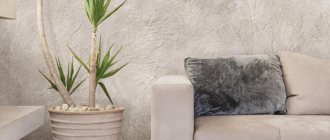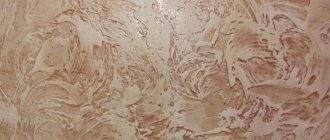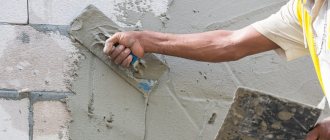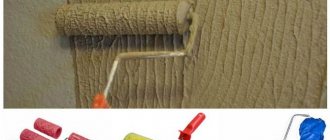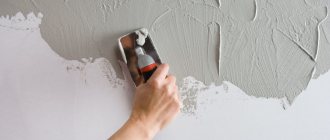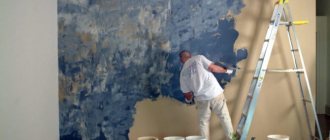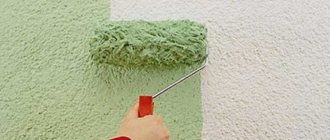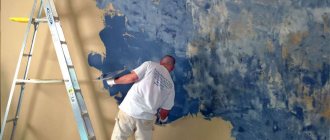We are all different: some are conservatives who do not approve of change and are difficult to encourage, while others are innovators who always need to change something and rush somewhere. Our attitude to change is manifested in any area: be it new housing conditions or major renovations. We have the same right to classify ourselves as one or another category of people, but you must agree that development still occurs through innovative ideas. And in this publication we will describe a not advanced, but very original way of finishing walls - wet silk plaster.
Characteristics of decorative plaster silk
The base material and adhesive component is acrylic. The mass is similar in consistency to paste. When decorating the walls, they look like stretched fabric.
The “liveness” of the interior is given by its ability to create play of shades with skillful lighting or viewing from different angles. Because of this effect, the mixture is called wet silk.
Its composition is in many ways similar to “Venetian”, but their characteristic difference is the finishing: Venetian plaster is covered with protective wax and polished, while silk remains matte.
Compound
Transparent acrylic and fibers play a special role in imitation of silk fabric. The polymer acts as a binder and creates a layer. Through it, light, refracted, falls on the fibers, which give texture to the material. So, wet silk decorative plaster consists of:
- acrylic;
- cellulose;
- polyester;
- from silk fibers;
- cotton
Some manufacturers suggest using glitter, mother-of-pearl or non-ferrous metal powder to make the composition more decorative. Inclusions are added as a separate component. On sale you will find colored plaster or “kohler”.
Forming a drawing using different techniques
The visual perception of the finished repair depends not only on the type of finishing material and its color, but also on how the craftsman will perform the work. The chosen application technique creates small nuances on which the resulting effect depends. In any case, the surface will look like it is covered with fabric, but some differences in the pattern are formed precisely by the method of application, and not by the characteristics of the material.
Smooth silk
photo from the site https://etotdom.com/
A classic technique that creates areas with different light refractive abilities, typical of a fabric prototype. If you decide to repair it yourself, the algorithm of actions will be as follows:
- Padding. It's best to apply a couple of coats to ensure there is sufficient adhesion over the entire area. Dry the primer according to the manufacturer's recommendations - from 1 to 4 hours.
- Base layer. Apply using a velor roller evenly over the entire surface. Drying time is from 2 to 4 hours. The base coat can be taken either the same color as the main one, or a little darker.
- The first layer of wet silk. Here we need a Venetian trowel. With its help, a uniform coating is formed over the entire area. The first layer will take about 8 hours to dry.
- Second layer. It is better to do this with a round plastic trowel, but a Venetian trowel will also work. The second layer is applied with short multidirectional strokes, after which it is smoothed out with even, without rounding, movements in different directions.
photo from the site https://stroyartdecor.com.ua/
Wet silk
photo from the site https://ds-faktura.ru/
Light fabric, when wet, changes its appearance, laying down in heavy sheets, and instead of flowing uniform tints we see a soft pattern with blurred contours. To get this effect, you need to do the following:
- Surface priming. Make sure that the primer saturates the coating well, otherwise the result of your efforts may soon peel off and crack.
- Base layer. Sometimes online you can find recommendations to use decorative plaster itself as the first layer, but manufacturers do not recommend deviating from the technology and produce a separate type of material for the base coat.
- A layer of silk plaster. You should work with a Venetian trowel, consistently covering an area of the wall of no more than 2 m², and leaving a torn edge, which is smoothed out when processing the adjacent area.
- Second layer of liquid silk. Apply using a round plastic trowel using smoothing movements in a circle or in a figure eight shape. Light pressure ensures the formation of curls of different directions and sizes.
photo from the site https://www.decor-inn.com.ua/
Crinkled silk
photo from the site https://pratta.ru/
This technique requires a certain skill and strict adherence to time intervals, because in order to design the texture it is important not to miss the moment when the plaster has already set, but has not yet dried. The work order will be as follows:
- Applying primer. Keep in mind that the more porous the substrate, the more primer you will need.
- Base coat. Do not use bases and plaster from different manufacturers; the chemical reaction can be unpredictable - from changing color to cracking of the dried surface.
- Decorative plaster “silk effect” is applied in two layers, exactly as with the classic smooth silk technique.
- 20 minutes later, after the initial setting has occurred, the surface is smoothed with a plastic spatula, which slightly stretches the plastic mass, forming relief folds. This needs to be done in different directions so that the drawing is chaotic.
The initial setting time may vary between different manufacturers and under different temperature and humidity conditions. Test it in practice in an inconspicuous place or on rough material.
photo from the site https://decor-live.com/
A video showing all the key points and a detailed description will tell you more about how wet silk decorative plaster is applied. Pay attention to the movement of the master's hands when applying the last layer. If you are working with this technique for the first time, you are unlikely to be able to apply plaster so easily and effortlessly, but with a little effort, everything will work out.
As you can see, silk-effect plaster has well earned its place in interior design. And thanks to the clear technique and simple application, you can save on paying a specialist.
Advantages and disadvantages of silk coating
Decorative plasters from different manufacturers have differences in price and components, but they will combine the quality characteristics of the material:
- ease of use in rooms with curved surfaces;
- no joints, seams, pattern adjustment, seamless coating;
- aesthetic appearance;
- creates a “breathable” air-permeable coating;
- Thanks to the plasticizers in the composition, the finish does not deform or break. Suitable for use in new buildings;
- does not fade in the sun;
- has antistatic properties;
- does not emit harmful fumes, can be used in a children's room.
There are much fewer disadvantages of decorative finishing and they are mainly related to the cost of the material.
- High hygroscopicity does not allow the material to be used in the bathroom and kitchen interior.
- Please note that silk actively absorbs odors.
Making different movements with a trowel or sponge will give you different effects.
Where to order and buy
As previously noted, silk plaster is expensive in price. Indicators usually start at 600 rubles and can reach 9 hundred just per m2. But the high cost is justified by the effect of iridescent silk.
You can place an order directly from the manufacturer, without intermediaries over the phone, or by using one of the online delivery services.
It is recommended to purchase products from certified points of sale
Using silk plaster in interior decoration, you can surprise your guests. The result is a luxurious environment that one can only envy. The high price is compensated by the effect produced, which not every analogue has.
Was this information useful to you? Share in the comments!
Required Tools
For work you need to prepare:
- putty knife;
- trowel or soft grater;
- container and roller for primer;
- grout washer.
Also, do not forget about materials for preliminary preparation of walls: putty, primer and paint.
Using a spatula apply the composition to the trowel
Using a trowel, apply the composition to the wall and create patterns.
Technology of applying decorative plaster to different surfaces
Depending on the type of surface being repaired, the conditions for preliminary preparation of the walls vary significantly.
- Concrete walls have a high penetration rate of any composition inside. If pre-painting does not guarantee a reduction in this property, it is rational to use putty. This will allow, among other things, to get better at it before the final stage of repair work. After the first layer of putty, you can paint the walls with a silk color (paint).
- Plastered walls should not have flaking areas; if any are found, the surface must be sanded and treated with a primer. You can protect yourself from surprises in the form of streaks or stains by painting the walls with alkyd or oil paint. It is allowed to use other paint and varnish products, but before doing this, test the reaction of the diluted dry mixture to the base coat in an inconspicuous area.
- The entire drywall must be puttied. The joints should be additionally covered with a layer of snow-white paint with the addition of PVA glue in a ratio of 3:1 in order to avoid the appearance of unevenness later. You also need to deepen the hardware well to avoid the appearance of rust spots on the outside.
- The surface covered with chipboard, MDF, moisture-resistant plywood must be puttied and coated with a primer.
- Protruding metal objects (sections of communication pipes, reinforcement elements) must be painted with nitro enamel or oil paint; after drying, you can begin the final part of the repair.
Different technologies are used for different surfaces
. To summarize, we note that silk plaster is a successful combination of different finishing methods, as it combines their best qualities plus convenience. Of course, its price is an order of magnitude higher than regular wallpaper, but its many advantages, coupled with long-lasting practicality, are worth it.
Primer
Decorative plaster is applied to a flat surface; this requires wall preparation. The process looks like this step by step:
- Before priming, the surface is freed from old materials such as paint, whitewash, wallpaper.
- Tap the walls, widen the cracks, remove loose parts of the former plaster.
- Seal all cracks and holes with putty.
- Areas with rust stains, areas affected by mold or fungus are cleaned and treated with anti-corrosion and fungicidal agents.
- Start leveling the walls with starting plaster.
- After the base has dried, it is necessary to smooth out any rough edges and remove dust from the surface.
- The next step is to apply primer paint to the walls. It would be correct to choose it to match the wet silk, for which it will serve as a base. The paint is applied in 2 layers.
To prevent the white plaster layer from being exposed during the technique, wet silk is applied in two layers
What is silk plaster and how does it differ from liquid wallpaper?
Alba silk plaster, despite its name, is a thin-layer coating, no more than 1-2 mm thick, which is applied to a wall that has already been prepared for painting, while liquid wallpaper has a thicker layer. It is created from a special putty-paint, which, after drying, resembles silk fabric stretched over the surface. Silk Plaster liquid wallpaper is related to silk plaster only because of the silk fibers included in the product along with cellulose and cotton. Essentially, Silk Plaster liquid wallpaper is created from paper and thread, while Alba silk plaster is created from environmentally friendly products - water, marble powder and pearlescent pigment. It is more durable, extremely easy to apply, and its durability is much superior to liquid wallpaper. Below is a comparison table.
Alba putty Sample 01
Alba putty Sample 02
Alba putty Sample 03
Silk plaster "Alba"
- High cost per m2 – from 450 rubles
- Color palette of more than 100 colors
- Ready for use, you just need to mix thoroughly
- High moisture resistance, dirt can be easily removed with water, the use of non-abrasive detergents is allowed. Water resistance is achieved by applying a colorless protective varnish, which makes it possible to use silk plaster in the kitchen and hallway
- Requires preparation for painting and application of a color base
- It is possible to master the application technique yourself without additional costs
- Does not hide surface defects. The base to be decorated should be as smooth as possible
- No seams or joints
- Suitable for any interior style
- Environmentally friendly product
- Not damaged or scratched, does not cause interest to pets
- Fireproof
- Does not absorb odors
- It is possible to change the color and pattern without dismantling the old one and preparing
Liquid wallpaper “Silk Plaster”
- The cost of m2 is slightly cheaper - from 300 rubles
- Limited color palette
- Requires mixing with water or adhesive component
- It requires a protective varnish to protect it from dirt and moisture. Cannot be washed, only dry cleaning is allowed. Stubborn grease or dirt stains are removed by removing and restoring the coating. Not recommended for use in the hallway or kitchen
- Preparation for painting, apply primer in at least two layers
- Organizing decoration requires a full hand
- You can hide defects by increasing consumption, which will negatively affect the final cost
- No seams or joints
- Traditional interior styles for wallpaper
- Eco-friendly product
- Requires restoration after contact with the cat family
- Combustible material
- Fabric fibers absorb odor
- Requires mandatory dismantling, sanding and preparation for plastering
Of course, if we conduct a more thorough analysis, this is not a complete list of the advantages and disadvantages of Alba and Silk Plaster silk plasters. However, after studying the table presented, you can easily decide which silk plaster to buy for your house or apartment. Practicality is perhaps the main quality that should be predetermining.
How to Apply Wet Silk to a Wall or Ceiling
After the surface is completely dry, start working with decorative plaster.
Application in one layer
Using a spatula, the material is applied to the trowel. Press the tool with its free edge to the surface and, having set the required angle, move it along the wall.
The material is transferred to the wall in a thin layer.
Do not forget that its thickness should not be greater than the size of solid inclusions. The next stroke begins, slightly extending beyond the border of the previous one.
If you intend to apply only one layer, then at this finishing stage, carefully polish the material using a washer or create the intended relief on a wet surface using auxiliary tools. If this layer is followed by a second, then the mixture is applied carefully, leaving no marks from the edge of the trowel.
Application in two layers
The second layer is applied after 6-8 hours. It should be lighter than the first one. The technique of applying decorative plaster with a second layer involves small movements in the opposite direction from the first. This allows you to create a “smoothed velvet” effect. To give the surface a certain pattern, use a variety of movements: waves, zigzags, circles, herringbones. At the end of the work, the base is polished with a float or washer.
The second layer can be applied with a thin layer of sea sponge
Materials and tools
The technique of cladding with “wet silk” is practically no different from the traditional application of mortar. There are only minor differences. The main feature is that a thin layer is formed, which is enough to protect the walls.
In addition, to work with decorative material you will need the appropriate tools:
- Venetian trowel;
- narrow spatula;
- velor roller;
- bath;
- decorative washer;
- stepladder, ladder (scaffolding);
- rags;
- latex gloves.
In addition, you need to buy a universal primer, as well as a color if the mixture is white or neutral in color. The peculiarity of the Venetian trowel is that, unlike a traditional trowel, the handle is not located in the same plane with the working blade, but slightly higher and in the center. This design of the tool allows you to use all 4 edges.
Crinkled silk effect: description of technology
There are many ways to create an imitation of crushed silk. Let's describe the most popular of them:
- We carry out all stages of interior finishing before applying the second layer;
- using a trowel, throw on enough material to “unscrew” a curl from it using a washer, perform a circular motion with light pressure;
- repeat the movement until the entire surface has been treated;
- proceed to the polishing stage: using the same circular movements of the washer, smooth out the applied pattern.
Further in the video you can clearly see the technique:
Video master class effect of crinkled silk
Where and how to buy silk plaster
Silk plaster, created from alba decorative putty, is always available at our warehouse in Shchelkovo or at the plant in Voskresensk. Buying silk plaster is not difficult - you can place an order on our website or by phone, visit the sales office and pick it up yourself or order delivery to your address. We cooperate with cargo carriers and deliver any volume throughout Russia. You can arrange the delivery yourself or entrust it to our specialists. We also have a recommended tool in stock. You can buy silk plaster from us and learn how to apply it absolutely free, master class as a gift.
Flowing silk effect
Do all the work, including applying the first coat. Then apply a second layer and, after it is lightly “grabbed” with diagonal movements across the entire surface of the trowel, the mass is given the effect of flowing silk. Don't forget to clean the surface of the tool from any accumulated plaster with a damp cloth.
Flowing silk effect
Video of creating flowing silk
Some nuances
This material is very demanding on surface preparation. Although it can hide small cracks, other defects will be noticeable. Therefore, it is necessary to eliminate any shortcomings.
It is worth paying attention to some features:
- Avoid using products called fiberglass. It can damage the decorative layer. This is due to the fact that the material has good absorbency, which even a primer cannot level out.
- If metal beacons were used to apply the starting composition, they must be removed. Otherwise, there is a high probability that traces of corrosion will form.
- Walls in rooms characterized by high humidity are treated with moisture-resistant impregnations. Antiseptics are applied in advance, which should protect against fungus and mold.
Many manufacturers of silk-effect plaster recommend observing certain time intervals. Namely:
- block walls must withstand an interval of several months after the starting coating has been applied;
- for brick walls the period is up to six months;
- if the work was carried out in winter (in frozen rooms), then the decorative layer is laid only in summer.
How to make it yourself
On store shelves, decorative plaster can be found in the form of ready-made dry mixtures or individual components for independent preparation. To knead silk with your own hands, you will need:
- acrylic additives;
- cellulose and artificial silk fibers;
- cotton;
- polyester.
We prepare the decorative mass using the following technology:
- add decoration to dry ingredients: glitter, crumbs. If you want more decorativeness, then add sparkles; if you want texture, then add crumbs.
- If you need to color the mixture, do so with a small amount of powder. Once you are satisfied with the intensity of the color, you can add the required amount of pigment to the remaining material.
- Prepare the recommended amount of warm water in a separate container.
- Add the dry mixture to the water, thoroughly mixing the mixture with gloved hands.
- Leave the composition to swell for 10-12 hours.
The remaining composition from repair work can be stored in a tightly sealed plastic bag.
Creating the effect of silk threads
“Silk threads” is a technique for applying decorative plaster, with the help of which a relief coating is obtained with long and thin vertical stripes across the entire surface. To create it, use the same acrylic plaster that is used for the “wet silk” coating.
For work you will need: the same tools + a decorating brush or a brush with stiff bristles.
Application technique:
- Prepare the base, apply a primer and leave until completely dry (12 hours).
- Cover the prepared surfaces with 1-2 layers of interior paint. Thanks to this, the hardening time of the plaster will increase, which will allow high-quality “threads” to be formed on the surface. Allow at least 2 hours between coats to allow the paint to dry.
- Acrylic plaster is thoroughly mixed and poured into a cuvette.
- The composition is applied using a fur paint roller. Layer thickness – up to 1 mm. If applied evenly, each square meter will require about 500 g of plaster. If they work alone and the surface area is large, treat 1 m² areas sequentially.
- While the material is not dry, use a plastic decorative brush to form the necessary relief. To do this, apply a brush to a wall covered with plaster, move it up and down, creating long vertical stripes.
- Before the solution hardens, you need to smooth the surface with a plastic spatula. During the process, excess composition will collect on its working edge; it must be removed with a clean rag.
- After the desired relief has been created on the surface, it is left to dry for 24 hours.
- Proceed to creating the finishing layer. Apply decorative varnish using a paint roller. While it is still wet, remove excess with a Venetian trowel. The pearlescent pigment penetrates into the recesses and is almost wiped off from the smooth surface, emphasizing the relief and enhancing the decorative effect. The varnish dries within 24 hours.
How to make “silk threads” in the interior yourself is shown in the next master class.
Silk-like decorative plaster is an elegant coating that is practical. Using various techniques, you can use it to decorate the walls of your kitchen, bedroom or living room in an original and stylish way.
Previous Decorative plaster “American” - a quick way of decorative plastering Next Decorative plaster Shagreen from plaster: cheap and quick wall finishing
Caring for decorative coating
Silk plaster for interior decoration is easy to care for: dust and dry particles can be removed with a vacuum cleaner. If dirt requires wet cleaning, it can be carefully removed with a cloth soaked in soapy water.
If necessary, plaster with a wet silk effect can be coated with a protective varnish or wax. In this case, it will be possible to use all types of cleaning, including abrasive detergents.
Sometimes the contamination or damage to the plaster is so severe that there is no other option but to remove the area. There is nothing wrong with this: decorative plaster easily tolerates “partial” repairs. To do this, you just need to wet the damaged area of the wall and remove it with a spatula. If you don't have spare material or the color is not what you need, you can use the removed stock.
What is silk decorative plaster and its types and composition?
At the moment, there are two types of mixtures that have almost the same name, but in essence are radically different from each other. Let's try to figure out what decorative mixtures for silk are and whether it is possible to apply them with your own hands without special training.
- Silk decorative plaster is a composition that includes fibers of cellulose, cotton, silk, etc. The name liquid wallpaper is more often used. It belongs to textured mixtures. A prominent representative is the compositions of the company Silk Plaster. Liquid wallpaper is applied without the use of special techniques and tools, resulting in an excellent wall finish.
- The second type includes pearlescent plaster with a silk effect. Such solutions are applied in a thin layer and have several application techniques. The recipe includes particles of mother-of-pearl, which give a unique effect. Such coatings are also called ottocento.
In the article we will pay more attention to the second type of finishing, which allows you to make an imitation of a wall covered with silk fabric.
Video. Basics of applying silk plaster SILK PLASTER
Manufacturers
The decorative mixture includes artificial or natural silk threads. The first group is produced by companies:
- "SILKOT" Japan,
- "SILCOAT" Türkiye,
- "SENIDECO" France,
- Russian
Their cost depends on the texture and composition. The second group is represented by:
- "Fujiwara Chemical Co" Japan,
- "BAYRAMLAR" Türkiye,
- “Peace to your home” Russia.
Of course, the quality of these products from these brands will be higher. The choice in favor of one manufacturer or another largely depends on the budget allocated for repairs.
What is silk plaster
Liquid wallpaper and silk decorative plaster are the same material. Both the first and second names are considered correct. The second name is used to distinguish this particular type of wall covering from the range of liquid wallpaper. The only difference from ordinary liquid wallpaper is that wet silk plaster contains artificial silk fibers. Because of the silk filler, the wall covering is called nothing less than velvet plaster. In addition to silk, the dry mixture contains water-soluble glue flakes, cotton fibers and cellulose. Various glitters and plasticizers are also added to the mixture.
Photos of finished works
If you are not yet motivated enough to work with this type of plaster, look at the photo:
Tyutyunnikov Dmitry
Article verified by a decorative finishing specialist
Textures and composition
The texture of silk plaster depends on the type of application, the density of the composition and additional inclusions, as well as consistency. In some cases it is relatively smooth, in others it is velvety. The smoothness of the surface is due to the thin fibers. In addition, the composition includes dyes and metallized pigments. The radiance effect is conveyed by interspersing mother-of-pearl microparticles into the mixture of polymer solution, due to which the coating appears voluminous. This material is made on the basis of astringent acrylic polymers and polyester threads with the addition of quartz chips, which liquid wallpaper does not have. The main components are cotton or cellulose fibers. Plasticizers increase the service life of silk plaster.
Repair of damaged areas of the coating
If, as a result of someone’s careless actions, the surface of wet silk was damaged, then the homeowner can independently make repairs. They do it like this:
- The damage area is marked with a pencil;
- the damaged area within the contour is generously moistened with water;
- Use a spatula to carefully remove the soaked finish;
- if the damage is deep, then the wall is puttied and primed;
- the dry mixture from the remaining residues is diluted with water and the damage is rubbed with the finished mixture using a trowel;
- work done correctly will not leave any traces behind.
Many people value liquid wallpaper precisely for its durability and the ability to easily and simply repair wall decoration.
Troweling damage to silk plaster
Silk effect in the interior
Liquid silk finishing is most in demand in the interior of rooms in sleeping areas. If you use wall painting along with silk textiles, the overall look of the bedroom will have a luxurious look.
Not only the wall, but also the ceiling will have a “silk” look - finishing surfaces with this type of dye will allow you to visually adjust the geometry of the room.
The second common place for finishing with liquid silk is the living room. Here you can use hand-made stencils to create an interior.
Silk effect coating options:
- chaotic pattern;
- star dust;
- artificial aging.
To create such patterns, you can use a sprayer, a roller with tape wrapped around the working part or pieces of material attached, or a brush with stiff bristles.
Silk printing will become indispensable for wall decoration in Baroque, Renaissance, and Empire styles. Also, “silk” walls will look impressive in classic interior design of the kitchen and hallway.
What is the material wet silk
Silk plaster is an expensive finishing material, but due to its high quality it is becoming a frequent choice among owners of apartments and private houses. Imitation of color shifts, unusual appearance, and performance properties allow it to be used for different rooms. The only exception is rooms with high humidity.
In appearance, it seems as if the wall is not covered with a finishing mixture, but is actually upholstered with silk. Some models even use real silk fibers in their composition. This provides the effect of fabric for the interior, but increases the price tag.
Sometimes putties can absorb odors, so you shouldn't use them in the kitchen.
Advantages and disadvantages of wet silk coating
The positive aspects of the finish are not limited to the unique composition alone.
Pros of silk putty:
- The material levels the surface of the walls and eliminates unevenness. However, craftsmen do not advise abusing this quality; it is better to level the walls in advance in order to reduce the cost of the composition.
- Suitable for almost any base. The use of a primer will ensure reliable adhesion of the decorative material to the wall. The unique composition of the mixture penetrates into all the irregularities of the wall, creating a seamless decor.
- Prevents the appearance of fungus and mold. For this function, manufacturers add special antifungal elements to the composition.
- Easy application process. This point makes up for the disadvantage of the high price. By spending money on the material, the apartment owner will save on the quick work of a craftsman or even do everything with his own hands.
- Ease of repair. As with other finishes, damage may appear on the surface of liquid silk plaster. The fix is simple; another option is to make a protective screen from clear acrylic varnish.
Disadvantages of coverage:
- Expensive components. Silk putty contains expensive elements; compared to conventional finishes, it will cost more.
- Not suitable for rooms with high humidity. The structure of the material is capable of absorbing moisture, which negatively affects the properties and appearance.
With good financial opportunities and an acceptable level of air humidity, the choice is obvious. The silk effect will change the interior and make it rich.
Preparation for work and material consumption
Before you begin, you need to prepare the walls for silk plaster. Although it is believed that the selected material, due to its texture, can hide some shortcomings. Still, you cannot compare the silk composition with full-fledged structural coatings that allow you to hide even severe unevenness. This means that walls should be carefully prepared for silk plaster. The surface must be leveled and covered with high-quality deep penetration soil.
Preparation stages:
- Preparation for plastering. As with any finishing, it is necessary to remove the remnants of the old or poorly adhering coating, remove dust and degrease the surface. To do this, you should use a vacuum cleaner and special chemicals.
- Leveling using cement plaster. It is used in cases where the wall has not been prepared at all or there are severe defects on it.
- Finishing putty. For final leveling and elimination of minor defects, we use putty.
- Primer. To improve adhesion, it is necessary to prime the surface. To do this, use soil, a tray, and a roller.
- Second coat of primer. If the surface is porous, it is worth applying a second layer of primer.
Decorative silk plaster is often used specifically for interior wall decoration. This means that the future appearance of your home will greatly depend on such a stage as preparation. Do not neglect the steps before the application itself, and you will greatly facilitate your subsequent work.
Tool that will come in handy:
- Hammer – to remove traces of previous finishing
- Scrapers and chisels - for the same purposes as a hammer drill
- Brush and vacuum cleaner - to remove dust and dirt
- Water with detergent - to remove traces of grease
It is better to use an industrial vacuum cleaner, because... a regular one will become clogged with dust, so cleaning it will be a problem.
When we start renovating everything, we wonder about the cost. And this is very closely related to consumption. To determine consumption, it is best to use the manufacturer's recommendations. Silk decorative plaster is not a very expensive material; its average consumption per square meter is 1 kg per layer per 3-5 m2. Laying usually takes place in 2-3 layers.
Let's calculate the consumption for a room of 18 m2. The wall area in such a room with two windows and a pair of doors will be 36 m2.
36:4=9 kg per layer.
Total: 18 kg for 2 layers.
Our online decorative plaster calculator will help you simplify the calculation.
White decorative coating wet silk costs around 2,500 rubles per 5 kg. This means that for a room of 36 m2 we will need about 10 thousand rubles.
Such figures are comparable to the cost of good wallpaper or expensive paints.
Plaster application technique
If you have chosen this particular decorative product, then all that remains is to calculate and purchase the required quantity and move on to the most interesting part - applying it to the walls. Usually, the package with the dry mixture contains instructions that will make it easier for you to use this mixture.
But usually the instructions for preparing the mixture always remain the same:
- prepare a convenient container, such as a basin;
- pour into the container as much water as indicated on the package;
- add the glitter that comes with the plaster and stir thoroughly;
- Now you can add the main mixture itself and mix it thoroughly.
The composition is ready for use, and you can begin applying it immediately. Your actions will look like this:
- Primer. First prepare the base - this is necessary for better adhesion of the plaster to the working surface. Use an acrylic primer designed specifically for decorative compounds to increase adhesion. The primer is applied with a brush or roller, whichever is more convenient for you. The entire surface is covered with an even layer. Can be applied in several layers.
- First layer. Prepare a plastic trowel; it should be narrow or medium in size. Use it to scoop up a little of the finished plaster, apply it carefully to the surface, the strokes should be chaotic, the gaps should be minimal. For the first layer, a thickness of 2 mm is sufficient.
- Second layer. You cannot create a silk effect with one layer. A second layer is required! The application technique will be no different from applying the first layer. To simplify the task of creating texture, use different rollers to apply the composition.
You can use different application techniques to achieve an interesting silk plaster texture. For example, the “droppe” technique involves applying short strokes that are directed in different directions. You will get an interesting plexus of leaves and curls. There is also the “moon” technique, where the mixture is applied in long strokes. And to achieve maximum imitation of wet silk, you need to apply layers very thinly - no more than 1 mm. With special rollers you can “draw” complex patterns and create folds on the applied “fabric”.
Despite the high cost of the material, it is very popular, because it is an excellent replacement for the usual wallpaper. With silk plaster, the interior immediately becomes more noble and majestic. And if you compare it with the usual wall coverings made of paper or vinyl, the plaster will last you much longer. It will not fade in the sun and will not begin to peel off from the walls. Therefore, if you have the opportunity and desire to create an unusual interior at home or in the office, you can safely buy this particular biologically friendly finishing material.
